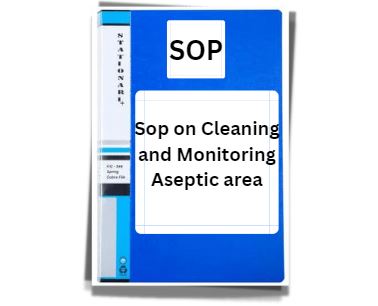In this Standard Operating Procedure (SOP), we will discuss the proper procedures for cleaning and monitoring an aseptic area including; their Objective, Scope, Responsibility, Cleaning, and monitoring by Setting Plate Tests.

1.0 Objective: This SOP gives guidelines for cleaning and monitoring of aseptic area in the injection section of the production department
2.0 Scope: This SOP on Cleaning and Monitoring the Aseptic area is applicable to the Injection section of the production department at the plant.
3.0 Responsibility:
Head – Production for overall compliance with this SOP.
Officer- Production for implementation of this SOP
4.0 DISTRIBUTION:
Master Copy: Quality Assurance Department
Control Copy: Production Department
Display Copy: Production Department
5.0 Procedure for cleaning and monitoring of aseptic area:
5.1 Cleaning Procedure:
5.1.1 As the filling process is over, make arrangements for the cleaning process.
5.1.2 Dismantle all the filling assemblies and other machine parts for washing purposes and transfer them into the washing area through a pass box.
5.1.3 Carry out the cleaning after 30 minutes of the completion of the filling process.
5.1.4 Remove any broken glass pieces of containers, vials, etc. Mop up any spoilage of material immediately.
5.1.5 Wipe out the surface with a 0.1% solution of disinfectant (on a rotational basis).
5.1.6 Wash out the entire filling area with the disinfectant solution assigned for the day.
5.1.7 Working person removes the garments in bins for cleaning and sterilization.
5.2 Various types of disinfectants assigned for cleaning purposes on a rotational basis
1st Working Day: Sterile 70% IPA
2nd Working Day: Hexilon 2.5%
3rd Working Day: Benzalkonium Chloride (BKC) 2% + Glutaraldehyde 5%
4th Working Day: Sterile 70% IPA
5th Working Day: Hexilon 2.5%
6th Working Day: Benzalkonium Chloride (BKC) 2% + Glutaraldehyde 5%
5.3 Monitoring Procedure:
A. Setting Plate Test:
1. Expose Petri dishes of sterile nutrient agar media, at specified points, in the aseptic area, for ½ hour.
2. Incubate the plates for 72 hours at 320°C.
3. Count the colonies of bacteria.
4. Further incubate the same plates for 48 hours at 200°C.
5. Count the colonies of fungus.
Frequency of Testing: On all working days and in all operational areas.
B. Setting Plate Test:
1. After setting up the machine entirely for the filling operation, pass the first 20 vials through the filling line, omitting the actual filling, including the sealing operation.
2. Inject sterile nutrients into the vial through the seal; shake the vials to bring both into contact with the seal.
3. Incubate the vials at 320°C for five days in an inverted or lay-down position and find the results.
Note: If daily contaminated vials are found, the filling procedure and even the testing procedure may require investigation.
6.0 Acceptance Criteria
Compliance with the above guidelines
7.0 Frequency
Carry out the test at an interval of one month.
8.0 Abbreviations:
SOP: Standard Operating Procedure
°C: Degree Celsius
%: Percentage

Naresh Bhakar is the Founder and Author at Pharmaguddu.com, bringing his extensive expertise in the field of pharmaceuticals to readers worldwide. He has experience in Pharma manufacturing and has worked with top Pharmaceuticals. He has rich knowledge and provides valuable insights and data through his articles and content on Pharmaguddu.com. For further inquiries or collaborations, please don’t hesitate to reach out via email at [email protected].
